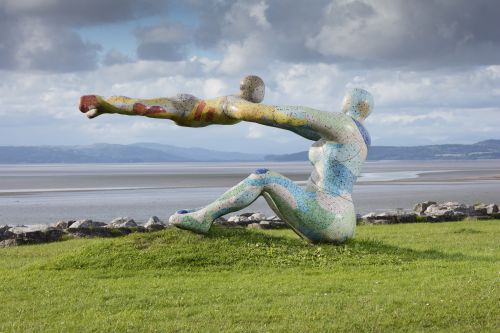As part of a broader focus on the recently discovered Neolithic ‘crannogs’ – artificially-constructed islands – in Scotland, the Islands of Stone project has been conducting data mining on 148 volumes of the Proceedings of the Society of Antiquaries of Scotland, 5 volumes of Archaeologia Scotica and 71 volumes of Discovery and Excavation Scotland, which were kindly provided as a single download by the ADS.
Islands of Stone is an AHRC-funded collaboration between the University of Southampton, the University of Reading and Historic Environment Scotland investigating Neolithic ‘crannogs’ in the Outer Hebrides. The construction of crannogs, or artificial islands, in Scotland was generally thought to have emerged during the Early Iron Age (c. 800 BC); however, one artificial island in the Outer Hebrides known as Eilean Dohmnuill, or Donald’s Island, has demonstrated much earlier origins. Originally believed to be of Iron Age date, excavations by Ian Armit soon revealed large quantities of decorated Neolithic pottery which would ‘change the direction of the entire research programme’ (Armit 1991: 444-45).
Nearly two decades later, the discovery of Neolithic pottery around several other artificial islands in the Outer Hebrides and two subsequent seasons of survey and excavation have now dated several of these sites to the Neolithic as well (c. 3500 BC) (Garrow, Sturt and Copper 2017; Garrow and Sturt 2019) (Fig. 1). These findings demonstrate that the construction of artificial islands during the Hebridean Neolithic was a wider spread phenomenon than previously thought and suggests the potential for additional islands with Neolithic origins to be discovered in the Outer Hebrides and perhaps Scotland more broadly. With nearly 600 artificial islands recorded in Scotland, these sites have received considerable attention by antiquarians and archaeologists alike, providing a wealth of information that serves as a starting point in the search for additional artificial islands with possible pre-Iron Age origins.

Background
The first notice of ‘artificial or stockaded islands’ in Scotland, called crannoges in Ireland and keltischen pfahlbauten (pile dwellings) in Switzerland, read to the Society of Antiquaries of Scotland was by Joseph Robertson in 1857. Regrettably, this notice was not printed in the proceedings as Mr Robertson wished ‘to avail himself of several important additions to his collections relating to these ancient remains’ (Robertson 1857: 35). However, the attention this new class of site would attract was immediate, and the following year John Mackinlay, inspired by Robertson’s ‘very interesting paper’, delivered his own paper to the society on two ‘crannoges’ or ‘pallisaded islands’ he had discovered and investigated nearly five decades earlier (Mackinlay 1857-8) (Fig. 2). Two years later, an ‘address on archaeology’ to the Society demonstrates that antiquarian interest in these ‘curious lake-habitations, built on piles of wood, or stockaded islands’ was on the rise (Simpson 1860: 27), but it was Dr John Stuart’s extraordinary 70 page paper on artificial islands or “crannogs” in Scotland (the culmination of Robertson’s earlier work along with his own) that really set the stage for the antiquarian exploration of crannogs (Stuart 1868).

This increasing antiquarian interest and the large body of information it would provide was largely possible due to the Improvement Period in Scotland when hundreds of lochs were drained across the country and the artificial nature of many unassuming islands was dramatically revealed. This drainage afforded antiquarians the unique opportunity to investigate these lacustrine structures on terra firma (or at least terra humida), uncovering the true complexity and extent of these often multi-phased artificial structures – it was not until 1910 that crannogs in existing lochs were able to be investigated underwater through the use of a ‘diving-dress’ – itself an engaging narrative of one of the first underwater archaeological investigations in the world (Blundell 1908-09). These early explorations led to the recovery of a vast quantity of archaeological materials and the beginnings of a highly engaging history of crannog research in Scotland (Fig. 3).
Currently, there are 442 crannogs or possible crannogs recorded on Canmore, Scotland’s National Record of the Historic Environment, yet of these, only around 50 have been excavated to any degree and less than half of those since the radiocarbon age. More recent projects have now resulted in absolute dates for around 60 crannogs (see Henderson 1998; Dixon 2004: Cavers 2010; Crone 2012; Stratigos and Noble 2014; Garrow et al. 2017), but it is clear that the majority of recorded crannogs remain undated and unexplored. Although all sites on the mainland have, thus far, been dated to the late Bronze Age or later (the majority being of Iron Age date), the recovery of Neolithic dates for artificial islands in the Outer Hebrides suggests the need to further explore the concept of the Neolithic ‘crannog’ – building a greater understanding of this site type in the Outer Hebrides and determining whether this phenomenon potentially could have extended beyond the archipelago.

Of course, this opportunity is also fraught with many challenges. The multi-phase, and in many cases multi-period, nature of these sites has submerged and literally ‘compressed’ their history, making the identification of the earliest phases of these structures highly challenging without extensive underwater investigations. Further, changes in loch levels during and since the Improvement Period, either through loch drainage or damming, have also obscured the visibility of many artificial islands, meaning that the only knowledge of these sites comes by way of antiquarian research and/or local knowledge. Hence, the antiquarian exploration of crannogs provides not only a necessary starting point in the investigation of Neolithic ‘crannogs’, searching for of any potential indications of pre-Iron Age phases that may have been overlooked or dismissed, but also a unique opportunity to re-explore the insights and intrigues of the earliest crannog researchers who would unwittingly lay the foundation for modern crannog research.
With much of this antiquarian work being presented to and subsequently published by the Society of Antiquaries of Scotland, it is with these publications that the process began. Utilising a programme of data mining in conjunction with machine learning, all volumes of the Proceedings of the Society of Antiquaries of Scotland (PSAS), Archaeologia Scotica and Discovery and Excavation Scotland, freely available through the ADS, were mined in order to identify any features or materials that may be indicative of earlier Neolithic origins and build ‘qualitative signatures’ of both Neolithic and Iron Age crannogs (i.e. associated materials and contexts). These results will, in the near future, then be combined with ‘ocular signatures’ derived from aerial imagery (e.g. size of island, distance from shoreline, etc.) to form a database of potential Neolithic crannogs that can then be ground-truthed through subsequent fieldwork.
Method
Uploading these publications into NVivo, a qualitative data analysis software, a text search query for the term ‘crannog’ (and its stemmed words: crannogs, crannoge, crannoges) allowed all mentions of crannogs in past publications to first be identified before any qualitative signatures and potential Neolithic associations could be highlighted. The results provide an indication of where and how many times this term occurs within these publications; of the 224 volumes analysed, 169 volumes contain the term crannog with 3502 total uses of the term (Fig. 4). Of course, not all of the results are relevant to our specific analysis as some refer to Irish crannogs or Swiss lake-dwellings and others only cursorily mention a crannog in reference to some otherwise unrelated topic. These instances often appear as only a single reference within a volume or article while higher reference counts indicate more in-depth discussions of crannogs or associated materials. For instance, in volume 6 of the PSAS – the volume containing Stuart’s 70-page paper – the term crannog appears 127 times, nearly six times more than all previous volumes combined, indicating the unofficial commencement of antiquarian crannog research. Thus, although the text search was intended to simply identify where mentions of crannogs occur within these publications, these statistics also serve to build a picture of the waxing and waning levels of crannog research in Scotland since the late 19th-century.

Having exposed all references to crannogs in these publications, each reference was then viewed in further detail to firstly determine its accuracy and relevance and secondly further divide the volumes or articles containing references to crannogs into groups of related content (i.e. crannog investigation reports, analyses of recovered materials, cursory mentions of crannogs). Further, the references themselves and any associated surrounding text was coded (grouped) into related contexts (e.g. associated terms, recovered materials, structural typologies, etc.). For example, reading the text around each use of the term crannog revealed numerous additional terms used in reference to this site type, such as lake-dwelling, pile dwelling, pile structure and artificial island. To gather additional references to crannogs that may have been missed due to variations in terminology, these associated terms were also run through the text search query; for instance, a text search for ‘artificial island’ produced two references to sites that were not exposed through a search for ‘crannog’ alone – both of which occurred before Robertson first established the use of the term ‘crannoge’ in 1857 (Fig. 5).

By reading through each reference to this site type (i.e. crannog, artificial island, pile dwelling, etc.), relevant references were identified and manually coded into groups of related contexts or associations in order to identify any potential signatures of Neolithic phases. For instance, the greatest indication of the Neolithic origins of artificial islands in the Outer Hebrides has been large quantities of Hebridean and Unstan pottery found on these islands and the surrounding loch bed – many of which are nearly intact and some even retain food residue on the inside of the vessel (Fig. 6). This material evidence has not been forthcoming on the Scottish mainland, however. In fact, the data mining revealed that pottery of any period is rarely recovered from mainland crannogs (with the limited exception of Samian ware dating to the Roman Iron Age), and instead, lithic implements may provide the strongest Neolithic signature.

Although lithic implements hardly present as definitive a marker of Neolithic phases as pottery, the data mining process has proved far more valuable than the identification of a ‘Neolithic signature’ by allowing for greater insight into not only associated contexts and materials (of both potentially Neolithic and later origins) but also how these associations were discovered and interpreted through time. Antiquarian researchers well understood the ‘celtic’ or Iron Age phases of crannogs, but the markings of earlier, potentially Neolithic phases at times, quite literally, seeped through the cracks. Often these finds were dismissed due to the prevailing archaeological thought, and some were, ironically, even used to argue for the Iron Age of date of other in fact Neolithic materials and sites. For instance, in 1930 J. Graham Callander delivered a paper on the culture and period of Skara Brae in which he cited the recovery of numerous stone axe-heads, flint implements and carved stone balls from Scottish crannogs as support for his argument that this now famous Late Neolithic settlement was actually of Iron Age date (Callender 1930-1) – indeed V. Gordon Childe, who, as stated by Callander, firmly believed Skara Brae to be Neolithic, was instead swayed by such arguments and would forever leave a symbol of this inducement in the form of his book, Skara Brae: a Pictish Village in Orkney (Orkneyology.com). This example not only hints at the presence of overlooked Neolithic phases but also warns of the complexities of working with multi-phase sites and the dangers of blanket approaches to typological dating.
Having completed the data mining process, an extensive database of Scottish crannogs has been generated in conjunction with data collated from Canmore and more recent crannog research. Amongst this database of 366 referenced crannogs, 16 are potential sites that have gone unrecorded in the HER (some of which have long since been destroyed) and 24 have been highlighted as having potential pre-Iron Age phases. Determining whether or not these sites actually contain Neolithic phases will have to wait until later phases of the project, but regardless, the data mining process has provided an invaluable understanding of the historiography of crannog research – the waxing and waning levels of interest, the controversies and conformities influencing interpretations and the overall insights and oversights of our antiquarian predecessors – an engaging and informative history of which the Islands of Stone project has now become a part.
References from the Proceedings of the Society of Antiquaries of Scotland
Armit, I. 1991. The Neolithic settlement of Eilean Domhnuill, Loch Olabhat, North Uist. Proceedings of the Society of Antiquaries of Scotland 121: 444-445.
Blundell, O. 1908-1909. Notice of the Examination, by means of a Diving-dress, of the Artificial island, or Crannog, of Eilean Muireach, in the South End of Loch Ness. Proceedings of the Society of Antiquaries of Scotland 43: 159-164.
Callender, J. G. 1930-1931. Notes on (1) Certain Prehistoric Relics from Orkney, and (2) Skara Brae: Its Culture and its Period. Proceedings of the Society of Antiquaries of Scotland 65: 78-114.
Grigor, J. 1862-3. Notice of the remains of two ancient lake dwellings or crannoges, in the Loch of the Clans, on the estate of James Rose, Esq., of Kilravock, Nairnshire (with a plan. plate II). Proceedings of the Society of Antiquaries of Scotland 5: 116-119.
Mackinlay, J. 1857-1858. Notice of two “crannoges,” or palisaded islands, in Bute, with plans. Proceedings of the Society of Antiquaries of Scotland 3: 43-46.
Munro, R. 1878-1879. Notice of the excavation of a crannog at Lochlee, Tarbolton, Ayrshire. Proceedings of the Society of Antiquaries of Scotland 13: 175-252.
Robertson, J. 1857. Notices of the Isle of the Loch of Banchory, the Isle of Loch Canmore, and other Scottish examples of the artificial or stockaded islands, called crannoges in Ireland, and keltischen pfahlbauten in Switzerland. Proceedings of the Society of Antiquaries of Scotland 3: 35-37.
Simpson, J. Y. 1860. Address on Archaeology. Proceedings of the Society of Antiquaries of Scotland 4: 5-55.
Stratigos, M. and Noble, G. 2014. Crannogs, castles and lordly residences: New research and dating of crannogs in north-east Scotland. Proceedings of the Society of Antiquaries of Scotland 144: 205-222
Stuart, J. 1868. Notices of a group of artificial islands in the Loch of Dowalton, Wigtonshire and of other artificial islands or “crannogs” throughout Scotland. Proceedings of the Society of Antiquaries of Scotland 6: 114-183.
Additional References
Cavers, G. 2010. Crannogs and Later Prehistoric Settlement in Western Scotland. BAR British Series 510. Oxford: Archaeopress.
Crone, A. 2012. Forging a chronological framework for Scottish crannogs; the radiocarbon and dendrochronological evidence. In M. Midgley & J. Sanders (eds) Lake Dwellings after Robert Munro, 139-62. Leiden: Sidestone Press.
Dixon, N. 2004. The crannogs of Scotland. Stroud: Tempus.
Henderson, J. 1998. Islets through time: the definition, dating and distribution of Scottish crannogs. Oxford Journal of Archaeology 17, 227-244.
Garrow, D. and Sturt, F. 2019. Neolithic crannogs: rethinking settlement, monumentality and deposition in the Outer Hebrides and beyond. Antiquity 369: 664-684.
Garrow, D., Sturt, F. and Copper, M. 2017. Submerged Neolithic of the Western Isles. Interim Report (March 2017).
Garrow, D., Griffiths S., Anderson-Whymark, H. Sturt F. 2017. Stepping Stones to the Neolithic? Radiocarbon Dating the Early Neolithic on Islands Within the ‘Western Seaways’ of Britain. Proceedings of the Prehistoric Society 83: 1-39.
This guest post was written by:
Dr Stephanie L. Blankshein
Research Fellow, Islands of Stone
Centre for Maritime Archaeology
University of Southampton
[email protected]






